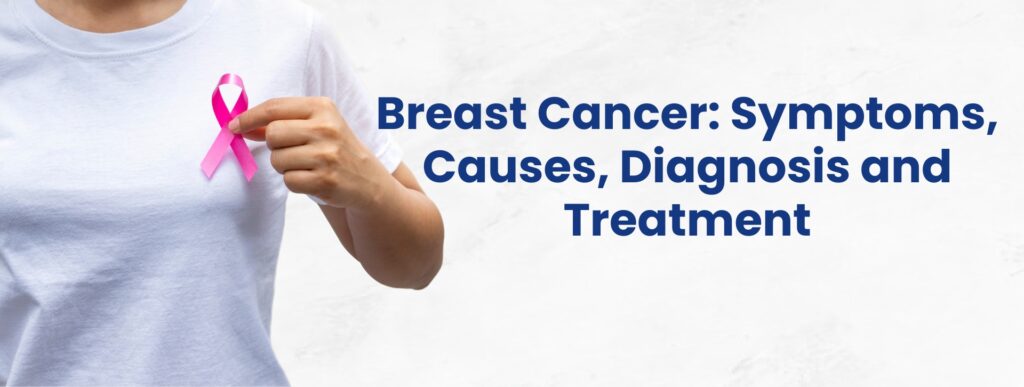Breast Cancer: Symptoms, Causes, Diagnosis and Treatment

Table of Contents
Breast cancer is one of the most common cancers affecting women worldwide. The World Health Organization estimates that breast cancer accounts for 16% of all female cancers globally. With the help of early detection through regular screening and knowledge regarding risk factors, outcomes can be significantly improved. We will address causes, symptoms, treatments, and ways to prevent breast cancer so you can empower yourself to take proactive steps towards safeguarding your health. Whether you or your loved one have been diagnosed with the disease or you simply wish to learn more, this comprehensive guide is meant to provide helpful insights and support for you.
What is Breast Cancer?
Breast cancer is a type of cancer that first grows in the cells of the breast tissue. It happens when the genes in normal breast cells mutate, allowing them to grow and divide uncontrollably and thus form a mass or a tumor. Over time, these malignant cells could invade nearby tissue of the breast and further spread to other parts of the body through the bloodstream or lymphatic system. Breast cancer may occur in women and men, though it rarely does in men.
What are the signs and symptoms of breast cancer?
- Breast lumps or thickening: Feeling a lump or an area of thickened tissue in the breast or underarm.
- Changes in nipple appearance: Changes in the shape, size, or direction of the nipple, such as inversion or retraction.
- Skin abnormalities: Redness, scaliness, or dimpling of the breast skin, resembling an orange peel texture.
- Nipple discharge: Unusual discharge from the nipple, which may be bloody, clear, or of another color.
- Breast pain or discomfort: Persistent pain or discomfort in the breast or armpit area that doesn’t go away.
- Changes in breast size or shape: Noticeable changes in the size or shape of one breast compared to the other.
- Swelling or lump in the armpit: A lump or swelling in the armpit area that may indicate the spread of cancer to lymph nodes.
What are the causes and risk factors of breast cancer?
Breast cancer is influenced by a range of factors, from genetics and hormonal influences to lifestyle choices and environmental factors. Here are some key causes and risk factors:
- Genetics and Family History: Family history and inherited mutations, such as BRCA1 and BRCA2, significantly elevate the risk.
- Hormonal Influences: Early menstruation, late menopause, hormone replacement therapy, and prolonged use of oral contraceptives can increase risk.
- Lifestyle Choices: Obesity, alcohol consumption, and physical inactivity are linked to a higher risk of breast cancer.
- Environmental Factors: Exposure to radiation and certain chemicals can increase the risk.
- Other Factors: Age, reproductive history, and dense breast tissue are also important risk factors to consider.
Understanding these factors can aid in early detection and prevention of breast cancer. Regular screenings and being mindful of these risk factors are crucial steps in managing your health.
Did you know that breast cancer primarily affects middle-aged and older women, with the median age at diagnosis being 62? Consult an expert to know if you are at risk.
How is breast cancer diagnosed?
The diagnosis of breast cancer involves a series of steps aimed at identifying the presence of abnormal breast tissue and determining the extent of the disease.
- Physical Evaluation: The diagnostic process often begins with a thorough clinical assessment, wherein healthcare providers obtain a detailed medical history and perform a physical examination of the breasts and surrounding lymph nodes.
- Imaging Studies: Many imaging examinations allow visualization of the tissue so that tumors can be detected. These may include:
- Mammography: Mammography is the first, and foremost imaging modality used for both screening and diagnosing breast cancer. It consists of taking X-ray images of the breast tissue for the detection of abnormalities, such as masses, calcifications, or architectural distortions. Digital mammography and tomosynthesis offer better visualization and improved detection rates compared to conventional film mammography.
- Breast Ultrasound: Ultrasound of the breast is also used as an adjunct to mammography, especially in cases where further workup for suspicious findings or dense breast tissue in women is required. Ultrasound works on sound waves to show structures in the breast and can also show solid masses from fluid-filled cysts.
- Breast MRI: This is a very sensitive imaging modality that uses magnetic fields and radio waves in producing high-detail pictures of breast tissue. It is generally used in high-risk patients, preoperative staging, and assessing the extent of disease in newly diagnosed breast cancers.
- Biopsy and Pathological Evaluation: It involves the use of a thin needle to aspirate cells or fluid from the mass of the breast or the suspicious lesion for cytological examination. There are basically different types of biopsies: fine needle aspiration, core needle biopsy, surgical biopsy, and so on.
- Additional Diagnostic Tests:
- Genetic Testing: Genetic testing may be indicated for those with a strong family history of breast cancer or clinical features that suggest one of the hereditary breast cancer syndromes, including but not limited to BRCA1 and BRCA2.
- Sentinel Lymph Node Biopsy: A sentinel lymph node biopsy is surgery to check if cancer in the breast has invaded nearby lymph nodes. It involves the identification and removal of the first lymph nodes that receive cancer cells from the primary tumor site.
- Staging and Treatment Planning: Once a diagnosis of breast cancer is confirmed, staging tests like imaging studies may be performed, such as CT scans, PET scans, and bone scans to assess the extent of disease spread. Staging allows for the determination of the appropriate treatment approach, including surgery, chemotherapy, radiation therapy, hormonal therapy, or targeted therapy.
Did you know that detecting breast cancer early can be a game-changer in beating it? Don’t ignore the symptoms; consult an expert today!
What are the treatment options available for breast cancer?
The treatment of breast cancer is multifaceted, often involving a combination of therapies tailored to individual patient characteristics, tumor biology, and disease stage. Here’s an overview of the primary treatment modalities:
- Surgery: Surgical management of breast cancer is the mainstay of treatment and includes the removal of cancerous tissues with preservation of breast functions when possible. There are two major categories of surgical procedures:
- Lumpectomy (Breast-conserving surgery): This procedure removes the tumor and a surrounding margin of normal tissue but saves the rest of the breast. Radiation therapy is generally performed afterward to get rid of any cancer cells that may remain.
- Mastectomy: In mastectomy, the entire breast tissue is removed surgically. Based on the extent of disease and according to the patient’s preference, mastectomy can be of different kinds: total mastectomy, modified radical mastectomy, and nipple-sparing mastectomy.
- Radiation Therapy: It uses high-energy X-rays or other particles to kill cancer cells and reduce the size of tumors. It is usually given after surgery to eliminate the remaining cancer cells in the breast or nearby lymph nodes. Radiation therapy can also be given as the primary treatment when surgery is not possible or desired.
- Chemotherapy: It is based on the administration of potent drugs that affect the fast-growing cancerous cells of the body. It is mostly applied concurrently with surgery or irradiation and has the main effect of reducing the size of tumors, clearing micrometastasis, and thereby decreasing the chances of the cancer relapse. Chemotherapeutic regimens are different and are based on characteristics such as tumor subtype, stage, and tolerance in patients.
- Hormonal Therapy: Hormonal therapy is specifically for hormone receptor-positive breast cancers, which encompass the majority of breast cancers. These cancers express receptors for estrogen and/or progesterone, permitting hormone-blocking medications to interfere with the growth of cancer cells. Common hormonal therapies include selective estrogen receptor modulators, aromatase inhibitors, and gonadotropin-releasing hormone agonists.
- Targeted Therapy: Targeted therapies are aimed at interrupting specific molecular pathways in cancer growth and progression. They have shown the most effectiveness in HER2-positive breast cancers, which overexpress the human epidermal growth factor receptor 2 protein. Targeted agents include trastuzumab, pertuzumab, and ado-trastuzumab emtansine; Kadcyla targets the overexpressed HER2 on cancer cells, leading to improved outcomes and survival rates.
- Immunotherapy: It harnesses the body’s immune system to recognize and attack cancer cells. While not a standard treatment for breast cancer just yet, ongoing research is looking into the efficacy of immunotherapeutic agents—such as checkpoint inhibitors and cancer vaccines—against certain types of breast cancer.
- Adjuvant and Neoadjuvant Therapies: While adjuvant therapies are given post-therapy to diminish the possibility of the recurrence of malignancy, neoadjuvant therapies are given before surgery to help shrink tumors and allow surgical resection. It forms an important area of the comprehensive management of breast cancer to achieve better long-term outcomes and improve survival.
Multidisciplinary team approaches between surgeons, medical oncologists, radiation oncologists, and other providers are fundamental to formulating and delivering individualized treatment plans that maximize outcomes for patients.
How can breast cancer be prevented?
Preventing breast cancer involves making healthy lifestyle choices, regular screenings, and understanding personal risk factors. Here are some key steps:
- Healthy Diet
- Regular Exercise
- Limit Alcohol
- Avoid Smoking
- Breastfeed
- Limit Hormone Therapy
- Regular Screenings
- Know Family History
- Preventive Medications
- Maintain Healthy Weight
- Limit Radiation
What are the latest advancements shaping breast cancer clinical trials today?
New and advanced breast cancer clinical trials are redefining the horizon of cancer detection and treatment today. Research is underway to not only enhance current screening modalities but also to personalize the examination for better breast cancer screening.
Scientific advances in imaging, such as 3-D mammography, are opening up bright possibilities for the detection of better and more extensive breast cancer. The Tomosynthesis Mammographic Imaging Screening Trial (TMIST) is under way to compare the effectiveness of 3-D mammography to standard 2-D mammography.
Conclusion:
Lastly, breast cancer remains a deadly opponent that takes millions of lives, perpetuates inequity, and burdens healthcare systems around the globe. But with raised awareness, access to care that does not discriminate, and collective action, we can stand up to this disease to empower people, communities, and nations around the world to overcome the scourge of breast cancer. Let us move together in this battle against breast cancer, standing for prevention, early detection, and comprehensive care for all.
References:
- https://www.cancer.gov/research/participate/clinical-trials/disease
- https://www.who.int/news-room/fact-sheets/detail/breast-cancer
- https://www.mayoclinic.org/diseases-conditions/breast-cancer
- https://my.clevelandclinic.org/health/diseases/3986-breast-cancer
- https://www.cancer.org/cancer/types/breast-cancer/about
About Author
Dr. A. Venugopal
MD (General Medicine), DM (Medical Oncology), MRCP – SCE Medical Oncology (UK), ECMO (Switzerland).
Dr A. Venugopal is One of the best medical oncologist and Hemato Oncologist in hyderabad, currently serving as the Head of the Department and Senior Medical Oncologist, Hemato Oncologist at Pi Health Cancer Hospital in Gachibowli, Hyderabad. He brings over 15 years of extensive experience in the field of Oncology.

